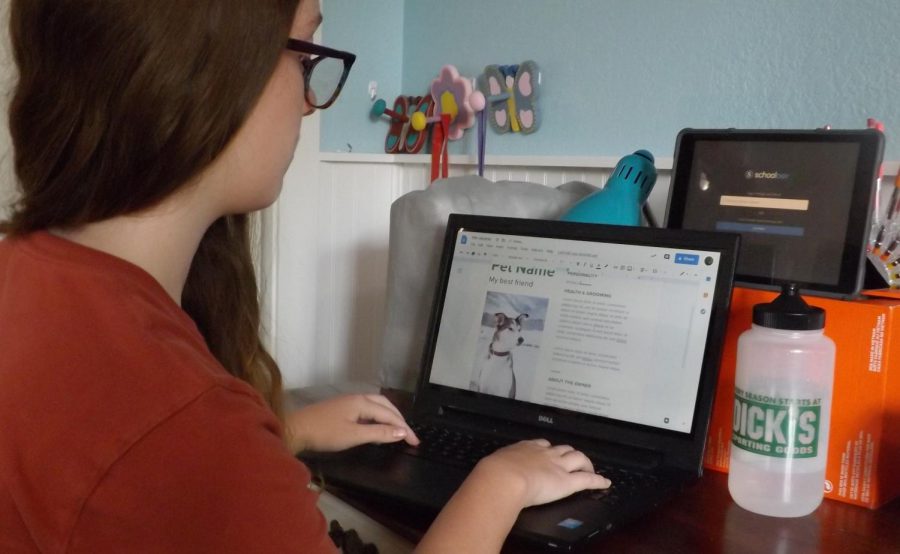How to manage the physical side effects of online learning
Many students in online learning are having trouble with the side effects of this format. These solutions may help.
There is a variety of ways we can fend off the side effects of online learning.
Many students in online learning have found that their bodies are aching a lot more than usual. Eyes are dry. Shoulders are hunched down over iPads. It almost feels like the way that we are sitting is going to turn our necks into the letter n. These are some of the side effects of the constant screen time during online learning.
Through this time, I have tried to make my technology environment have less of a negative impact on my health. Some ways have been very… well… let’s just say unsuccessful. It is a little embarrassing when your iPad falls over when you’re discussing something in class. That’s what I get for trying to use a dented, beat up, old tissue box as an iPad stand.
Other attempts have actually been pretty successful.
After all these trials, here are some suggestions that you may find useful:
1. Dry Eyes and Eye Strain
I have recently found a way to make it so that the iPad light (or any other blue light device) doesn’t blind me all day long (or however long I’m on that thing). Before, I would put the brightness levels down all the way, but I later learned that this was not doing me any favors. In fact, it was straining my eyes even more. I was going to have granny vision at age 30! According to Entertainment Times, “the brightness of your gadget should be equivalent to the light surrounding you, such that both the lights’ radiance is similar”, so keep the light the same as in the room or environment you’re in.
Another method of saving eyes is to use the night shift option on the iPad. By holding down the brightness level bar, and clicking on the “moon inside the sun” icon, night shift can be activated. Apple says that the warm colors of this option will make the iPad much easier on the eyes, and to be honest, my eyes aren’t as dry now that I started using this.
I was also recently given the suggestion from another student to update my Google Drive. When doing so, it will give you the option to change your theme. Just click on “settings”, then “theme”, and switch it to “dark”. Google says that this will make it easier on your eyes. For me, so far, it has definitely helped.
I also use prescription reading glasses to protect my eyes from the blue light. This helps with headaches and eye damage. The glasses that block blue light are a good choice as well.
2. Neck Trouble
No, you don’t need those neck pillows for planes or long car trips, though those are comfy. All you need is a chair, a table, and a shoebox. Place your iPad onto the shoebox so that instead of craning your neck to look down at your screen, it can be at eye level. I first used a Kleenex box, but my iPad was constantly falling over. Your iPad still has a risk of falling a tiny bit, but would you rather have neck issues that could cause you pain for many years to come or an iPad that occasionally falls over? You tell me.
Posture is everything for relieving pain. It fixes your shoulders, necks, and so on. Try your best to maintain good posture with your shoulders back and your head held high instead of craning down. Keeping your iPad at eye level will keep you from slouching over it and looking down constantly. Some students have necks that are still developing, so you want to be careful to not let your neck grow curved from looking over an iPad.
I would recommend a wide, sturdy box and strong tape to tape the sides of the lid down (the lid helps hold the structure of the box). I have found that a more bulky lid makes it harder for your iPad to stay balanced, so try to find a shoebox with a thinner lid. It is important to not leave the screen slanted up or down, just right across from your eyes. Turn the box on its side so that the lid is facing away from you. Make sure that the flattest side of the box is on the top.
3. Headaches and Migraines
Many students are suffering from migraines and headaches due to the screens and technology used for learning. I know from past experiences (from being in school) that not many students drink water during the day. Water is a no-brainer. It makes up about 60 percent of our human body, according to the United States Geological Survey. Water also hydrates the body and brings in oxygen.
Like I said before, blue light glasses also help too, or reading glasses. I know that my prescription reading glasses really help with ridding myself of headaches from screens.
4. Cramped or Sore Wrists
Online learners are creating future wrist pain by constantly using small mobile devices like iPads, says Hackensack Meridian Health. Everyday I have to pop my wrists — yes, literally pop them — in order to be able to move them better (don’t worry I have gotten this checked).
Whenever I do need to type a long paragraph or essay, I whip out the ol’ keyboard. I would suggest using a computer, laptop, or mobile plug-in keyboard. This will really give your fingers and wrists mercy during what feels like a strictly online time.
5. Focusing
Being online and in a different environment can make students lose focus. I find that when I start to drift off, classical music is a big help. In fact, classical music can also help raise your IQ and increase logical thinking and ability, says the Sphinx Music Organization.
A great thing to have more centered thoughts is a clean, quiet space. I’ve found that when I work in the kitchen around my family, I get distracted much easier and always end up heading to my room in the basement to do my work. But a quiet place doesn’t always have to be your room. It can just be a place where only you are the main inhabitant and where there are no distractions or constant, loud noises. You can also change up where you work too! This helps give you a change of scenery.
It is important to get a breath of fresh air every once in a while. Sometimes I will work outside or open a window. I would recommend doing some sort of activity or work outside for at least 20 to 30 minutes straight. Being outside in the sun can lift your mood and keep you healthy.
I know that this online learning can make you want to laze off and slouch all day, but it’s important to stay on top of our health and well-being. That way when we start going back to school full-time, we can feel the best that we can.
Your donation will support the student journalists of Mead High School. Your contribution will allow us to purchase equipment and cover our annual website hosting costs.

Skylar Whalen is a senior. She is this year's editor-in-chief. Skylar enjoys painting, singing, and playing softball. She is a huge animal lover and works with dogs outside of school. Skylar plays competitive softball and hopes to play in college. She is excited to help other writers succeed and grow. Skylar can’t wait to work with new people and produce engaging stories for the community around her. She also enjoys having the excuse to write about herself in third person and make her seem interesting.












Kaitlyn Randolph • Oct 21, 2020 at 1:21 pm
These tips are so useful! I have recently turned my brightness to about the same brightness of the light around me and honestly my eyes aren’t as tired as they usually are by the end of the day! Keep up the good work and thank you!
Candy Berkenkotter • Oct 18, 2020 at 2:28 pm
Great ideas. I especially liked the parts about the lighting, and how to adjust it to the surrounding light. Very creative designing a box for your IPad, The idea about how you need to make sure you are looking straight rather than down makes a lot of sense. Great article and points to make online learning a little easier and safer.